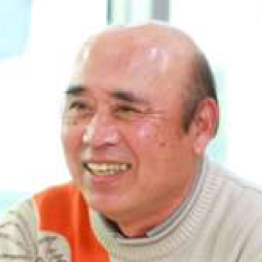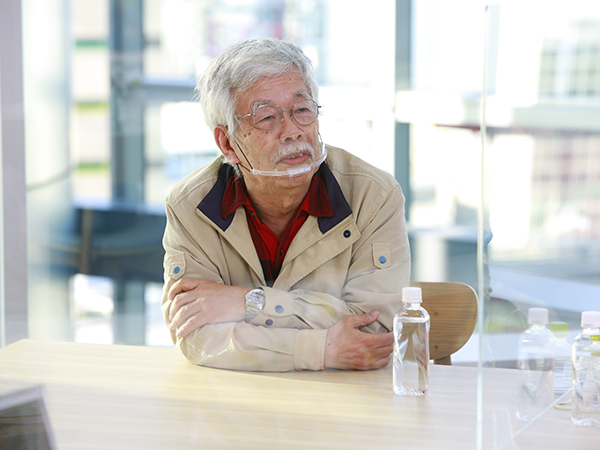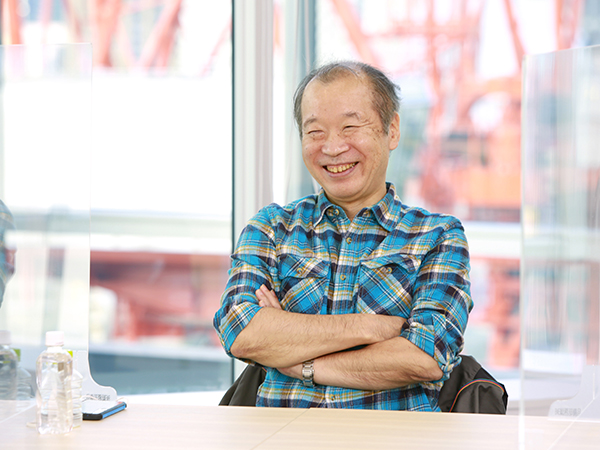PAC-MAN has been a beloved franchise worldwide since its launch in 1980, and this year it celebrates its 40th anniversary. Asobimotto took this opportunity to gather some of the key figures who worked on the original game for a 3-part look at PAC-MAN’s history.
*This article was originally released in Japan on January 26, 2021.
In Part 2 of our 3-part story we cover the sensation that PAC-MAN became in the early 1980s. We continue our discussions with some of the key people involved in the development and production of PAC-MAN.

Toru Iwatani
Planning & Game Design

Toshio Kai
Sound Design (Game start music, coffee break cutscene music)
Mr. Kai joined the Nakamura Manufacturing Company in 1970. He worked not only on 30test and other arcade machines, but also produced music for Galaxian and PAC-MAN. Additionally, he worked on developing names for game titles until the mid-80s as well as designing the NAMCO logo.

Shigeichi Ishimura
Board Design
Mr. Ishimura joined the Nakamura Manufacturing Company in 1976. He worked on not only the arcade version of PAC-MAN, but also the Famicom releases of PAC-MAN and RIDGE RACER, and designed content for mobile phones starting in 1999; growing the mobile content market. Mr. Ishimura went on to become president and CEO of NAMCO in 2005.

Sho Osugi
Cabinet Design
Mr. Osugi joined the Nakamura Manufacturing Company in 1972. He was an expert cabinet designer who worked on a number of arcade games. Mr. Osugi designed cabinets for a number of NAMCO games in the 70s and 80s including FORMULA-X, SUBMARINE, PAC-MAN, Galaga, and FINAL LAP.

Tadashi Yamashita
Character Design (characters, logo font)
Mr. Yamashita joined the Nakamura Manufacturing Company in 1970. He worked on over 30 games including PAC-MAN and Galaxian (designing both logo and graphics). Mr. Yamashita is currently a committee member of Shinkyo Bijutsu Kyokai and is active as an artist.

Hiroshi Ono
Cabinet & Marquee Designer
Mr. Ono joined the design department in NAMCO’s development division in 1979. He worked on design and pixel art for over 80 games including PAC-MAN, Galaga, and XEVIOUS. Since 2016 he created works of pixel art under the name “Mr. Dotman,” exhibiting his pixel art and holding workshops.

Yoichi Haraguchi
Production (Semiconductor Procurement)
Mr. Haraguchi joined the Nakamura Manufacturing Company in 1973. He worked in the production division procuring semiconductors for games such as PAC-MAN and Libble Rabble.

Akiyoshi Sarukawa
Domestic Sales
Mr. Sarukawa joined the Nakamura Manufacturing Company in 1976. He was head of domestic sales for titles such as PAC-MAN, SUBMARINE, and XEVIOUS.

Katsutoshi Endo
Domestic Location Business Management
Mr. Endo joined the Nakamura Manufacturing Company (later NAMCO) in 1963. He worked as head of Domestic Location Business Management for games like PAC-MAN and XEVIOUS.
Slow But Steady – PAC-MAN Gains Popularity in Japan

Osugi: With PAC-MAN (1980) and Galaxian (1979) right before it, we had people in the office tossing their work aside to play on the test machines we had set up.
Iwatani: Whether or not people would play during their lunch breaks was one of the parameters we used to judge a game’s popularity.
Osugi: We had some people hanging around to play even after they finished work for the day. That was enough to convince me that the game would sell. I probably made it to stage 12 or 13 myself. It’s a game that asks you to figure out its patterns to a certain degree and learn to read them.

Sarukawa: We held a private showing (*solo corporate exhibition) ahead of PAC-MAN‘s release. A first for NAMCO, I believe. But there wasn’t really a sense that the other business people attending offered any sort of strong reaction. Back then, the games industry was made up of mostly shooting and racing games. PAC-MAN was an extreme deviation from this, and it probably left a lot of them unsure of what to make of it. I distinctly remember an attendee from Hokkaido though, someone not usually the sort to play games, who kept playing until the end of the show. It offered a good look at how the game would reach a wider audience.
Sales of the game started afterwards, but we ended up having more than enough units on hand at the start. But 40 to 50 days after we shipped the units out, we heard from our vendors that while sales were by no means astronomical, they were more consistent than those of Galaxian, and we started to see PAC-MAN sell more and more.
Endo: Mr. Iwatani said (in Part 1) that he wanted to make a game that would be enjoyed by men and women alike, and I knew we had made a game that could be played by all sorts of people when I saw a woman playing PAC-MAN alone in a coffeehouse. I would see situations like this pretty often, too, as I went around to the locations we had cabinets set up in. We would see couples excitedly playing games together before, but it was pretty rare to see women playing these games all by themselves.
The game held on and continued to sell domestically, eventually spreading further and further. About 6 months after release, it really started to sell in larger numbers.

The Fight Against Illegal Copies Was Formative on the Advance of Today’s Game Industry
You mentioned (in Part 1) that games would sell well for the first 1 or 2 months after they released, but fall off quickly after that. But that was not the case with PAC-MAN, was it?
Sarukawa: Not at all. But you see, back then, from the release of Galaxian in 1979, and through the releases of PAC-MAN, Galaga, POLE POSITION, Dig Dug, and then XEVIOUS in 1983, we were in a constant battle against pirated copies of our products. The way NAMCO handled this back then was to seek payment for what were called “dead copies” (verbatim duplications), and distribute seals of consent to those who paid. I think we charged 20,000 yen per seal. We would go around and check these pirated copies to see if they had a seal, and to verify if the numbers on them were legitimate. There was a big effort by the company in this area up until around the time XEVIOUS came out.
There were so many copies of titles on the market back then, but NAMCO had a firm policy of not making copy titles. This, and our process of investigating copies of our games, left NAMCO in a completely isolated position in the industry. But the judicial decision on the PAC-MAN Case in 1984 (*1) went on to form the foundation of today’s game industry and support its growth, so I think NAMCO’s stance back then deserves a bit more credit. If we had simply continued to accept the presence of pirated copies on the market, I don’t think the game industry would have grown to be what it is today. The competition that arose from that court decision ties into the technological progress we see today.
*1 PAC-MAN Case in 1984: A lawsuit concerning the copyright of NAMCO’s PAC-MAN video game. NAMCO sought and was awarded damages for infringement of its screening rights by illegal copies of PAC-MAN installed by companies running coffeehouses. This led to computer program works being specified in copyright law in 1985.

Sarukawa: Between the release of Galaxian in 1979 and PAC-MAN in 1980, the game industry saw the popularity of SPACE INVADERS peak, with the game bubble set to burst. Back then vendors didn’t carry much weight, and it would usually be about a year from the time they bought machines from a manufacturer, installed them, and finished payment on them. That meant that any who got units fast would see favorable earnings, but if the games dropped in popularity before payment was finished, they would be stuck, unable to turn a profit. With more and more vendors stuck in these situations, Galaxian and PAC-MAN were truly two industry-saving titles.
But the bill for SPACE INVADERS had to be paid off with revenue from games such as Galaxian and PAC-MAN, so if there weren’t any hit successors, next they would be left unable to pay for Galaxian or PAC-MAN, either. So what we did was try and reduce payment periods, take collateral, ask for co-signers, and implement a number of other measures. This gave us a soft landing without any major issues.
Thanks to NAMCO’s further hits following PAC-MAN.
Sarukawa: Exactly. People continued to play PAC-MAN long-term, and our competitors also released a number of games. NAMCO had recently bought out ATARI Japan, so I imagine the company was in a tough situation financially, so PAC-MAN certainly helped in some part to save both the company and the industry.
A Gateway into Gaming – PAC-MAN Fever Overseas

PAC-MAN certainly has fans worldwide today, but can you tell us about your expansion overseas back then?
Haraguchi: PAC-MAN released overseas half a year after it came out in Japan, and became a much more massive hit than it had domestically. It found explosive popularity the moment it was released in the United States. What started with an order for 3 thousand machines soon turned into 20, then 30 thousand, and the game quickly began to spread. But in order to prevent illegal copying, we had implemented a gate array (an IC which could be programmed per-order), but we ran into trouble because the manufacturer could only produce 3,000 a month. I believe I turned to Mr. Ishimura for advice.
Ishimura: You did. Which meant that we had to take this black-box of an IC chip we had worked so hard to design for our anti-piracy measures and reconstruct it with general-purpose parts.

What do you think made the game so popular with players overseas?
Iwatani: My own personal analysis is that the reason a game like this, with a cute aesthetic and no particular thrill to it, found such popularity was because its simple controls allowed men and women, young and old alike to play. If SPACE INVADERS was the game in Japan that gave first-time players a taste of how fun video games could be, overseas it was PAC-MAN. With its popularity PAC-MAN ended up being a lot of overseas players very first video game.

Haraguchi: I remember there was a cable car in San Francisco that was decorated with a PAC-MAN design.
Yamashita: One time when I was overseas, I had a man hug me when I said I was the character designer for PAC-MAN. He said something like, “You’re amazing!” I’d get asked for my autograph, too.
Kai: It wasn’t quite that way yet in the early 80s, but by 1982 PAC-MAN had become incredibly popular in the US.

1982 was when the PAC-MAN cartoon aired in the US and Buckner & Garcia’s song “Pac-Man Fever” made it to the US top 10 music charts.
Haraguchi: We had situations in the US where we would get a call in the early afternoon saying a machine was broken, and when we’d go to check it out, we’d find that it was because the machine would fill up with coins so fast (from so many people playing) that players couldn’t put in another coin to start. I couldn’t help but be impressed every time we got word of situations like these.
Kai: At some point during the 80s I got asked to take a call coming in from the US, and when I picked up the line it was Yoko Ono (wife of former Beatles member, John Lennon) on the other end. I talked to her myself, and she said she just had to have PAC-MAN. Andy Warhol (famous artist) made a piece based on PAC-MAN, too. It all really drove home how much of a presence PAC-MAN had become.

Yamashita: I remember sending an autographed illustration to Yoko Ono. I think it was written out to her son, Sean Lennon.
Celebrating 40 Years of PAC-MAN – Thoughts from the Project Team
PAC-MAN is still adored by many even today, 40 years after its release in 1980. Can you tell us how that makes all of you feel?
Ishimura: We worked to create the original PAC-MAN 40 years ago, but it was the support from all of the other staff who worked on the titles over the following decades and the players who continue to enjoy the games to this day that have upheld its legacy. People spoke of PAC-MAN as the symbol of video games in the 80s when it became a hit, but it was still so new back then that it hardly felt real. 40 years later, though, I think the reason PAC-MAN holds such a strong position in the industry is because of everyone who fostered the games all this time. Really, what I feel is the need to say thank you and express how grateful I am.

Sarukawa: That’s how I feel, too. I want to thank everyone for sticking by and supporting PAC-MAN all these years. It brings me so much joy to see all the ways in which PAC-MAN makes an appearance these days.
Ono: It would please me so much to see PAC-MAN continue to undergo new development, mixing and collaborating with many different things, captivating even wider audiences.

Kai: Reflecting back on it now, we had this incredible environment 40 years ago in which Mr. Iwatani, in all his originality, could make these fantastical remarks, those around him allowed him to take on such endeavors, an earnest programmer was put on the team, and we all came together to make something great. I think that was of real importance to NAMCO itself, too. I’m happy to have been a part of working on such a great product.
Yamashita: PAC-MAN stands up on his own as a character today, and the series has changed course as times changed over the years. I honestly think the series is much more well developed today. But watching the character grow over the years has felt a lot like watching my own child mature.

Iwatani: One thing I can say is that they certainly let me run wild for a long time after I joined the company. Also, I bring up everyone’s names whenever I get interviewed, but for lack of space or whatever reason they always seem to get cut and my name is left, making it seem like I made PAC-MAN all on my own. But PAC-MAN was made through the cooperation of everyone here today and so many other people, too. The reason PAC-MAN has lived on to be loved worldwide these 40 years is because of the teamwork of everyone involved, including those involved in marketing and sales. I’d like to express my thanks once again to everyone who played a part.
PAC-MAN faced some difficult times in a changing era, but it provided so many opportunities too, such as the one which led me to teach game design as an academic discipline at a university and found an academic gaming society. I would also like to say that even with all the things I have experienced over the years, I still think there is untapped potential in video games. Games can move on from being something played just for fun to become methods of solving societal issues, and I am looking forward to thinking through the games of the future, including areas of gamification.

*Details from the interview are current as-of early November 2020.
*Participants removed their masks only for photographs.
Editor’s Note
Here in Part 2 we discussed PAC-MAN post-release and what it was like when the game grew to be a hit worldwide. What stood out most in this discussion was how grateful the members were for all those involved in spreading the joy of the series, making PAC-MAN into something beloved by many for the past 40 years. In our final section, Part 3, we talk about how PAC-MAN grew from there, and the titles that followed.
Jin Sugiyama
Freelance writer & editor. More fond of entertainment than just about anything.
▼Read Part 3 of the article





Mr. Iwatani joined the Nakamura Manufacturing Company (which would later become NAMCO) in 1977. He designed games such as GEE BEE and Bomb Bee in addition to PAC-MAN. Mr. Iwatani currently works as Professor Emeritus at Tokyo Polytechnic University.